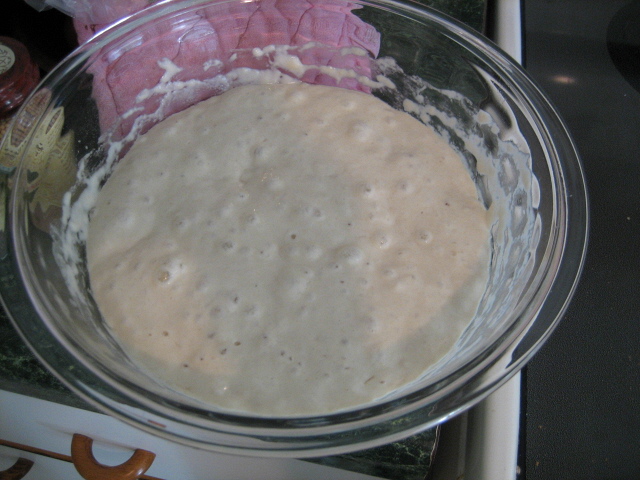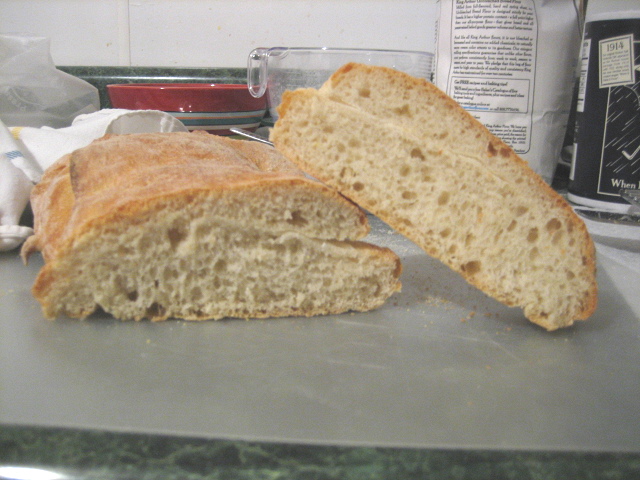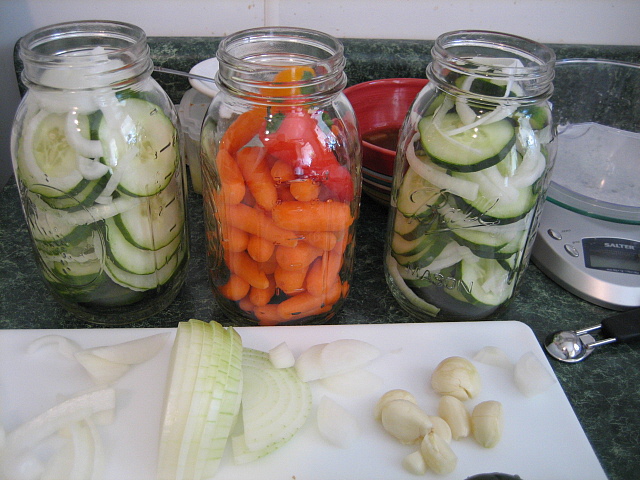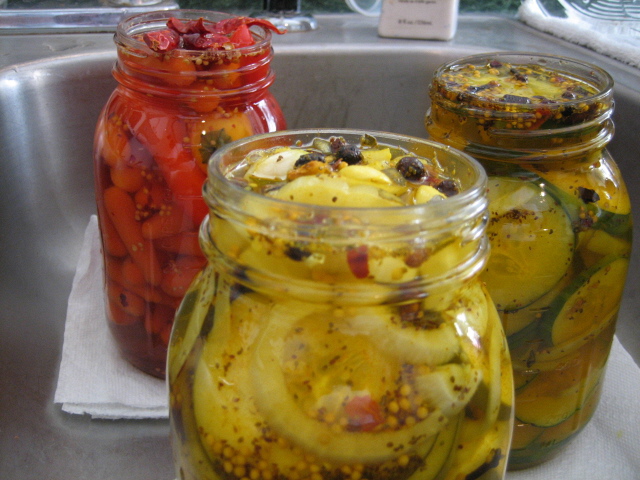Or, more accurately, bread and pickles.
I love to bake just as much as I love to cook. Some people may think the two are the same thing – after all, you throw some ingredients together, heat it or cool it, and then you eat it, right?
Wrong.
There’s a saying that will tell discerning readers (or eaters, for that matter) a thing or two about the difference: cooking is an art. Baking is a science.
There’s a reason for this. Baking in general requires fairly exact proportions in order to come to an end result that is actually edible. Anyone who has accidentally dumped too much salt into a cookie recipe will know how things can go terribly awry in baking. With cooking, most mistakes are recoverable – that is, mistakes can often be worked around or dealt with in a way that still leaves you with something to eat.
Where is this all leading? Bread, of course. My favorite thing to bake and my favorite baked good to eat. In the past, I’ve generally done what most people would recognize as loaf-type breads: cinnamon-raisin, with or without the raisins, whole wheat or honey wheat, and so on. The doughs for these breads are firm and easy to work with. Having made all sorts of loaves before I went in for surgery last year, I wanted to try something different this time around. Something I’d never done before, with a dough type that I’d never handled. I chose ciabatta: a wet, sticky dough that requires some care in handling in order to get a good crumb (the inside of the bread, where all the holes are). Anyone who has eaten a sandwich on loaf bread knows that the holes are very small and very consistent. Not so on wet dough breads like ciabatta. The holes vary wildly throughout, and the bread itself feels airy when held: light in the hand, with a nice crust.
Since I am the adventurous type, I dove right in. After all, flour is cheap, and if the end result is awful, it goes into the trash and a new batch is made with an eye toward improving whatever went wrong the first (or second or third) time.
The bread begins with a starter dough. The first dough is made and then left to ferment anywhere from several hours to overnight. There are two options: a biga and a poolish. The latter is looser than the first, more liquid. Since my goal was experimenting with very loose, wet dough, I went with a poolish to begin. The poolish is mixed and then left at room temperature for 3-4 hours. Once it is bubbly, it goes to the refrigerator for anywhere from several hours to three days, to be pulled out about an hour before use. This is my poolish after about 12 hours in the refrigerator:

It is very wet, loose, and sticky, and goes into the second dough mixture. Working with the finished dough was quite interesting, and difficult. The idea behind this type of bread is not to “degas” the bread. The bubbles in the dough are what will form the crumb and give the holes discussed up above. After a couple of folds and resting periods, the dough was split into three loaves, stretched a bit, and folded again, then allowed to proof again. Once that’s completed, it’s baking time. The bread was baked directly on a stone, and cooks very quickly. The loaves took about 12 minutes each. You’re supposed to allow the bread to cool for 45 minutes before cutting, but there had to be a sacrificial loaf. This was the first cut – well, technically, it was the second, as my mom scooped up the first cut, slathered some butter on it, and ate it.

While I am not displeased with my first effort – the bread smells terrific and, according to the first taste tester, is delicious – I can see some room for improvement. The crumb is nicely developed, but could go a step or two further.

The irregular holes can be seen, but I’d like them to be larger and would like there to be more of them. I believe this is either the result of insufficient kneading or of losing too much gas during the folding processes. The dough is rustic, but I’m not thrilled with the folds I got, as there is a pronounced seam as well. Next time, I think I’ll do two slightly larger loaves rather than three smaller loaves. On the plus side, the dough is airy and the loaves are light. The crust is nicely formed and browned, courtesy of the steaming in the first few minutes of baking. So I’m going to tag this one as a partial success and continue to experiment with this dough. This first round will go well with Wednesday night’s dinner: filet mignon with lump crab and a bernaise, roasted asparagus with balsamic vinegar and parmigiano-reggiano, and spinach au gratin. I know, two greens in one dinner, but they were requests, and who am I to turn those down?
Aside from the baking experiment, I also made some pickles.

From left to right, those will be: sour garlic pickles, “firecrackers” (courtesy of Alton Brown), and bread and butter chips. The firecrackers just call for baby carrots, but I found some sweet peppers at the store, so I tossed a few in with the carrots after cutting a slit in the side of each one. I made the pickling mixture for each one, and poured it over the goodies in the jars.

Clockwise from the top, those are the firecrackers, with a few dried chiles added after the jar is filled, the bread and butter chips, and the sour garlic pickles. I would have liked to have done spears for the last, but was unable to find some decent sized cukes that would have been suitable, so chips again. Maybe as we get into the season we’ll have better luck with that. The pickles were all cooled to room temperature, then lidded and refrigerated. As with most pickled items, these will no doubt get better as they age, but I’m going to have my tasters sample them Wed. night. There will be plenty of pickles around here down the road – I’m a huge pickle fan, and not just pickled cukes – so I’ll be able to do my own tasting 24 hours into a pickle at some point. I’d like to do a pickle of other veggies, like a cauliflower and red pepper pickle, maybe with some red onion. I think that would be rather tasty.
Tonight: a fabulous dinner. I’ll definitely take a couple of pictures of this one for your viewing pleasure.
